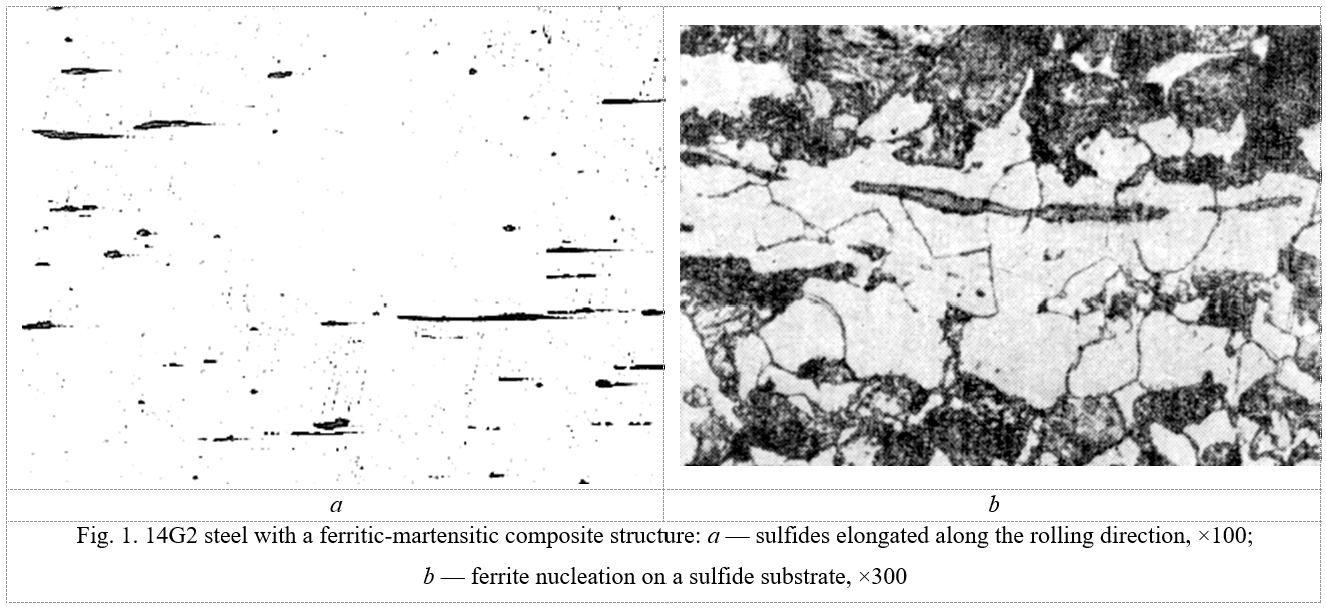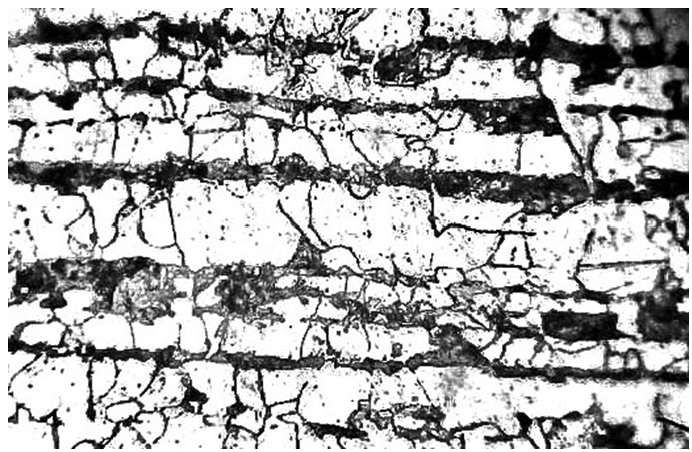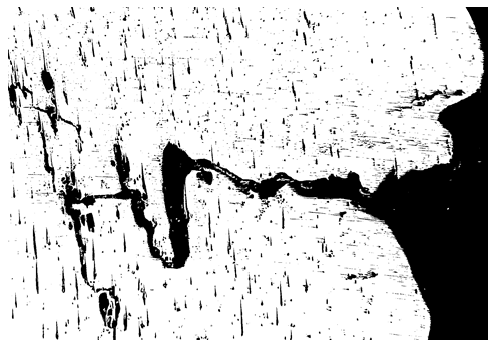Scroll to:
Structural Organization of Steel to Ensure Special Equipment Safety
https://doi.org/10.23947/2541-9129-2023-1-70-75
Abstract
Introduction. At present, great success has been achieved in the field of creating effective protective materials. Various non-metallic, metal-ceramic, and also composite materials act as armor elements. However, most of the armor elements of vehicles and personal protective equipment (PPE) are steels that, along with high ballistic resistance, have a high mass. In this regard, the relevance of the article is related to the possibility of lightening typical protective elements when using a material that has a structural organization like a natural ferrite-martensite composite (NFMC).
The work objective is to evaluate the prospects of using steel with an oriented structure as an effective protective material when exposed to high-speed concentrated impact of high power in comparison with the steel materials used.
Materials and Methods. The features and disadvantages of effective armor steels are revealed, a comparative analysis is carried out with steel oriented as NFMC. The assessment of 14G2 steel microstructure state with different hardening temperatures (730 °C and 760 °C) was carried out by the method of microstructural analysis. In relation to the topic of the study, the prospects for the use of low-carbon ferritic-martensitic steel were shown based on the laws of fracture mechanics and their comparison with the experimental data obtained on a sample of 14G2 steel with dimensions of 150 × 44 × 7 mm after testing for bullet resistance by cartridges with a steel core and armor-piercing cartridges with a tungsten core made of SVD rifles and AK-74 assault rifles of 7.62 mm and 5.45 mm caliber, respectively.
Results. The possibilities of resistance to fracture of steel with an oriented ferritic-martensitic structure are evaluated in comparison with typical homogeneous and heterogeneous steel materials. The resistance of such steel is related to the nature of the development of fracture, expressed in the deceleration of the crack during delamination at the ferrite-martensite boundaries. When a delamination is formed, a crack expends energy on delamination and changes its direction, which subsequently leads to a complete stop of the fracture process.
Discussion and Conclusion. The disadvantages of armor elements made of homogeneous and heterogeneous steel materials, associated with a high effective thickness of the protective element and the laborious process of obtaining a steel sandwich, respectively, can be solved by using oriented ferritic-martensitic steel. The data presented indicate a higher fracture resistance due to a special crack propagation mechanism, which is relevant in the development of armored vehicles. This makes it possible to reduce the total mass of combat vehicles associated with a decrease in the effective thickness of protective elements while maintaining the required class of resistance to high-speed impact loading, which will increase their mobility and reduce fuel consumption.
Keywords
For citations:
Pustovoit V.N., Dolgachev Yu.V., Ivankov I.V. Structural Organization of Steel to Ensure Special Equipment Safety. Safety of Technogenic and Natural Systems. 2023;(1):70-75. https://doi.org/10.23947/2541-9129-2023-1-70-75
Introduction. A characteristic trend in the development of military equipment is the permanent improvement of protective materials. So, instead of thick sheet metal, they are moving to the creation of multilayer metal, as well as non-metallic and metal-ceramic compositions. At the same time, the process of creating effective protective materials pursues two goals — reducing the mass of the protective element and increasing its ballistic resistance. These mutually exclusive factors make it possible to increase the mobility of combat transport systems and ensure safety from the effects of various firearms and fragmentation types of injuries. To simultaneously achieve the above goals, it is proposed to use steel with a structure organized as a natural ferrite-martensitic composite (NFMC) as an effective protective material.
Materials and Methods. The development of the above materials began with the desire to increase the resistance to high-speed high-power impact of hot-rolled homogeneous steel sheets with different carbon content and different degrees of alloying. So, in work on obtaining bullet-resistant steel material1, the advantages of alloy carbon steel of the composition, % are reflected: carbon — 0.44–0.48; silicon — 1.2–1.6; manganese — 0.3–0.6; chromium — 1.3–1.7; nickel — 1.4–1.8; molybdenum — 0.2–4; iron — the rest. This steel, after quenching and low tempering, has a hardness of about 55-57 HRC and, with a plate thickness of 4.0 mm, provides the 3rd class of protection against a 7.62 mm steel PS bullet (cartridge 57-H-231) of the AKM assault rifle and a 5.45 mm PS bullet (cartridge 7H6) of the AK-74 assault rifle. Such a material has a small effective thickness (8-9 % less than typical steels), but its destruction occurs by the mechanism of brittle destruction (usually an armor plate split occurs). In addition, the production of such steel requires careful control of chemical composition. An increase in viscosity and a change in the nature of destruction require a decrease in the material hardness. However, if the hardness is below 48 HRC, when tested with bullets with a heat-strengthened core, the material is penetrated, although the destruction is viscous.
To eliminate this drawback, two- and more layered steel compositions were created. They are made by explosion welding, pack rolling or surfacing methods [1, 2]. The basic principles of the development of two-layer materials are reduced to obtaining a high hardness of the front layer (about 58-60 HRC) and a high viscosity of the back layer with a hardness of at least 50 HRC. Tests of double-layer steel compositions have shown that when firing from an SVD rifle (caliber 7.62 mm, cartridge 7-B3-3, armor-piercing incendiary bullet B32), sheets are not broken at thicknesses of 10.2–10.6 mm. However, with a higher resistance of these materials, the effective thickness, compared with homogeneous steel armor plates, is almost 2-2.5 times greater.
The use of three-layer compositions with a low-carbon steel interlayer [3] makes it possible to reduce thickness of the armor plate to 8.9 mm. However, a significant disadvantage is the complex technological process of obtaining multilayer armor plates. For reliable adhesion, labor-intensive explosion welding, hot rolling with compression up to 70 %, and in some cases, a combined method with subsequent heat treatment is used.
This paper shows the advantages of a protective material in the form of steel with a structure organized as NFMC.
Results. The well-known technology for NFMC production2 consists in controlled rolling in the intercritical temperature range (A1–A3) of steels with a carbon concentration of 0.1-0.2 % to orient in the direction of rolling the ferritic and austenitic phases with a compression ratio of at least 30 % and subsequent quenching. However, rolling in this temperature range is quite time-consuming, as it requires the presence of powerful rolling equipment. In addition, with a low degree of compression, it is not possible to obtain a strict orientation of the ferrite-martensitic structure.
At the same time, obtaining a ferrite-martensitic composite is possible in a less labor-intensive way. Strict orientation of the structure can be obtained by using the following technological mode3: hot rolling with at least 70 % of compression, followed by cooling to an intercritical temperature range (AC1–AC3), exposure in this interval for phase refining, quenching followed by low tempering. Such processing does not require powerful rolling equipment and can be carried out in a conventional rolling shop. At the same time, it is necessary to control the sulfur content at the upper level of the grade composition (0.04–0.05 %) to form a sufficient amount of sulfides (Fe, Mn)S, which are stretched into thin plates during rolling (Fig. 1 a) and are substrates on which excess ferrite is formed (Fig. 1 b), forming elongated plate formations along the rolling direction. The perlite structural component is also oriented (Fig. 1 b).
 Varying the quenching temperature from the intercritical interval, it is possible to obtain different ratios of the volume fractions of ferrite and martensite4, as well as different concentrations of carbon in martensite and, consequently, different hardness of martensite plates. As a result of this process, an oriented ferrite-martensitic structure is obtained, providing anisotropy of the material properties (Fig. 2).
Varying the quenching temperature from the intercritical interval, it is possible to obtain different ratios of the volume fractions of ferrite and martensite4, as well as different concentrations of carbon in martensite and, consequently, different hardness of martensite plates. As a result of this process, an oriented ferrite-martensitic structure is obtained, providing anisotropy of the material properties (Fig. 2).
 Fig. 2. 14G2 steel with NFMC structure after quenching from 780 °C (29 % martensite), ×360
Fig. 2. 14G2 steel with NFMC structure after quenching from 780 °C (29 % martensite), ×360
Theoretical calculations [4] show that layering (artificial or natural) increases fracture toughness of the material and reduces the crack propagation rate.
For NFMC structure, it should be noted that martensitic layers in the ferritic matrix have a finite length (discrete fibers) and some misorientation of ferrite and martensite layers. In this case, as noted in [5], high fracture resistance is provided when the volume fraction of the hardening phase is ~20-25 %, a certain length of fibers from the hardening phase (martensite) is greater than a certain critical value (lкр ≥80 microns), and the misorientation of ferritic and martensitic layers is no more than 15.
Test results [6] of steel plates with NFMC structure (dimensions 150×44×7 mm) with steel-core cartridges and armor-piercing tungsten-core cartridges from the SVD rifle and AK-74 rifle of 7.62 98m and 5.45 mm caliber showed that a sample with a small thickness of ferritic layer and low-carbon martensite (quenching from 760 °C) was almost always destroyed. At the same time, a sample with a greater thickness of the ferritic layer and a higher carbon martensite (quenching from 730 °C) showed high ballistic resistance (Fig. 2). This sample did not collapse after being shot by armor-piercing bullets; the metal was deformed by 2-3 mm with the projectile ricocheting, while a small crack formed on the back side.
High ballistic resistance of steel with such a structure is associated with a special mechanism for the development of destruction in the material. When, during the movement of the crack, it approaches the ferrite-martensite boundary, stratification occurs in the ferrite (Fig. 3), as a result of which the crack changes the direction of movement and spends energy on ferrite stratification. The subsequent development of the fracture leads to a change in the crack trajectory with ferrite stratification, stopping the movement of the crack and stress relaxation at its apex.
 Fig. 3. Direction of movement of a crack in a material with NFMC structure having a vertical orientation of layers, ×50
Fig. 3. Direction of movement of a crack in a material with NFMC structure having a vertical orientation of layers, ×50
This result is consistent with the data of works [4, 7, 8], which indicate that discontinuities may form in the layered material along the interface during the fracture process, transferring the crack to a position less favorable for its propagation and leading to the deceleration of the fracture.
Discussion and Conclusion. Thus, the test results show that the use of steel with NFMC structure provides a high level of ballistic resistance with a lower effective thickness and complexity of manufacturing this material. This indicates its advantages over homogeneous steels and multilayer steel compositions. A special method of braking destruction with high-speed local exposure to high power provides a higher threshold of survivability of protection, and reducing the effective thickness increases the mobility of combat vehicles and personnel by reducing the total mass of protection.
1Kamaev E. A., Sakharov S. A. Vysokoprochnaya bronevaya listovaya stal'. Patent 2185459 C1, Russian Federation, C22C 38/44, No. 2001124667/02, 2002. (In Russ.).
2Supov A. V. et al. Termicheskaya i termomekhanicheskaya obrabotka stali i chuguna. Metallovedenie i termicheskaya obrabotka stali i chuguna. Spravochnik. Moscow: Intermet Inzhiniring, 2007. Vol. 3. 919 p. (In Russ.).
3Pustovoit V. N. et al. Sposob polucheniya estestvennogo ferritno-martensitnogo kompozita. Patent No. 2495141, Russian Federation, C21D 8/00, C21D 8/02, No. 2012119557/02, 2013. 7 p. (In Russ.).
4Lavrinenko V. Yu., Posalina A. E. Issledovanie vliyaniya predvaritel'noi termicheskoi obrabotki na poluchenie dvukhfaznoi ferritno-martensitnoi struktury stalei 20 i 20G2R. Novye tekhnologii v uchebnom protsesse i proizvodstve: mat-ly XX mezhdunar. nauch-tekh. konf. Ryazan, 2022. P. 111–115. (In Russ.).
References
1. Перспективные стали для защиты специальной техники / В. В. Цуканов [и др.] // Вопросы оборонной техники. Серия 16: Технические средства противодействия терроризму. — 2018. — № 1–2 (115–116). — С. 86–94.
2. Гладышев, С. А. Броневые стали / С. А. Гладышев, В. А. Григорян. — Москва : Интермет Инжиниринг, 2010. — 334 с.
3. Шишкин, Т. А. Комбинированный метод изготовления бронестали / Т. А. Шишкин, Л. Б. Первухин // Известия Волгоградского государственного технического университета. — 2020. — № 11 (246). — С. 53–57.
4. Krausz, A. S. Fracture Kinetics of Crack Growth / A. S. Krausz. — Springer Netherlands, 2011. — 196 p.
5. Wood, W. A. The Study of Metal Structures and Their Mechanical Properties / W. A. Wood. — Elsevier Science, 2014. — 400 p.
6. Пустовойт, В. Н. Баллистическая стойкость стали со структурой естественного феррито-мартенситного композита / В. Н. Пустовойт, Ю. В Долгачев, Ю. М. Домбровский // Безопасность техногенных и природных систем. — 2022. — № 3. — С. 54–59. doi: 10.23947/2541-9129-2022-3-54-59
7. Пустовойт, В. Н. Сценарий роста трещины в стали со структурой ферритно-мартенситного композита / В. Н. Пустовойт, В. В. Дука, Ю. В. Долгачев // Известия Волгоградского государственного технического университета. — 2017. — № 10 (205). — С. 118–121.
8. Structural Organization and Properties of a Natural Ferrite-Martensite Steel Composite / V. N. Pustovoit, Y. U. Dolgachev, Y. M. Dombrovskii, V. V. Duka // Metal Science and Heat Treatment. — 2020. — No. 62 (5-6). — P. 369-375. doi: 10.1007/s11041-020-00570-9
About the Authors
V. N. PustovoitRussian Federation
Viktor N. Pustovoit
1, Gagarin Sq.
Rostov-on-Don
Yu. V. Dolgachev
Russian Federation
Yuri V. Dolgachev
1, Gagarin Sq.
Rostov-on-Don
I. V. Ivankov
Russian Federation
Ivan V. Ivankov
1, Gagarin Sq.
Rostov-on-Don
Review
For citations:
Pustovoit V.N., Dolgachev Yu.V., Ivankov I.V. Structural Organization of Steel to Ensure Special Equipment Safety. Safety of Technogenic and Natural Systems. 2023;(1):70-75. https://doi.org/10.23947/2541-9129-2023-1-70-75








































